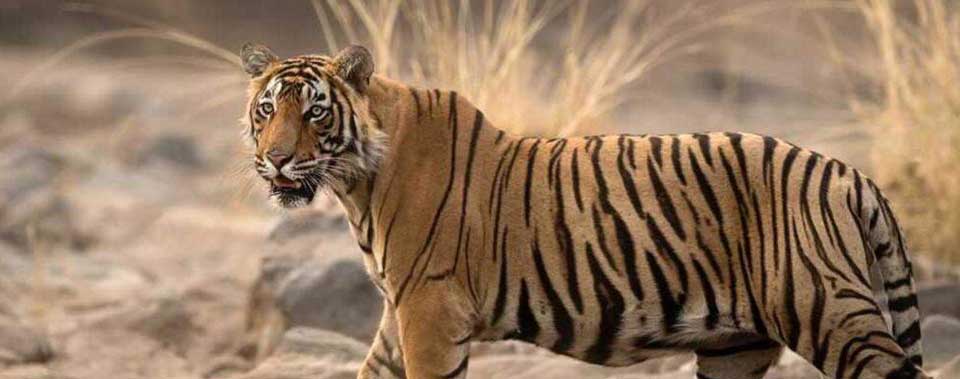Spread over the area of 392 sq. km in which 274 sq. km is the core zone and 118 sq. km is the buffer zone, the Ranthambore tiger reserve park is located in the Sawai Madhopur district of Rajasthan state of India. As the Ranthambore forest is the reserved tiger park, The Indian tiger or the Bengal tiger (Panthera Tigris) is the prime and most revered species in the park. The forest is incorporated into the tiger project in 1973 and later in 1980 declared as the national park. The Ranthambore reserve national park is the largest stretch of Anogeissus pendula (Dhok) forest in India. The land is the home to more than 40 species of mammals as well as around 320 species of birds, approx 40 species of reptiles and more than 300 of flora species.
This tiger reserve is small in area compare to the many other tiger reserves of India. Due to which, tiger spotting is easier than other parks. Also, the forest of Ranthambore remains dry for around 9 months in a year, making it one of the most visited parks in the country and chances of catching a sight of the majestic tiger is rather high. The park is currently having the total count of the tiger around 63 in which 40-45 are adult tigers and the remaining are cubs and semi-adult. The tigers at Ranthambore are usually of diurnal nature and hence can be easily spotted during the daytime, in the visiting hour of tourist safari.

The park was first established in 1955 by the Indian government as the Sawai Madhopur Game Sanctuary which later in 1973 declared as the tiger reserve forest. The adjoining forests were given the name of Sawai man Singh Sanctuary and Keladevi Sanctuary, which are also incorporated in the tiger project and declared as the part of the tiger reserve area of Ranthambore Park. The park is located at about 160 km southeast of Jaipur, which is the capital of Rajasthan state and also the nearest airport. The nearest railway station is the Sawai Madhopur station, which is 11 km away from the forest entry gate. The park is well connected to the major cities of Rajasthan as well as to the Delhi through the highways and can be reached very easily by road.
There are two types of vehicle is available for the safari - one is a jeep having six seats and the second is a canter having 20 seats. The total of the 20 jeeps and 20 canters are allowed in one shift and both the vehicles are the open from the top and sides especially modified for the best viewing experience. All these vehicles are attached to the forest department for the safari tour. The guide or trackers also are the registered naturalist and belong to the local communities who know the Jungle since many generations and very well aware of the behaviors of the wild animals of the park. As there is a large rush of wildlife tourist in the Ranthambore, so it is highly advised to book the safari, especially the jeep safari in advance before visiting the Ranthambore. At the entrance of the park, some formalities are necessary to fulfill at the entry gate such as filling up the forms with the naturalist details, visitors' details, etc.
The Ranthambore national park got its name from the historic Ranthambore Fort, which is situated inside the park. Enclosed by the Banas River, also known as Van Ki Asha, in the north and Chambal River in the south, the Ranthambore national park touches the borders of Uttar Pradesh and Madhya Pradesh borders, the two states of India. This park is considered as the best place to see the Bengal Tiger and other wildlife.